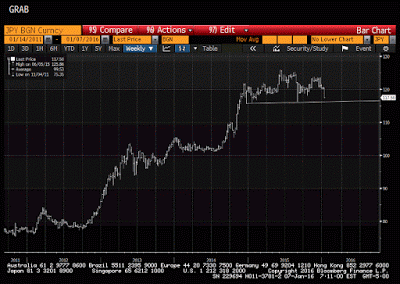Summary:
The dollar has broken down against the yen. Although many talk about safe haven role for the yen, this seems to be a misconception. Investors are not buying the yen to escape the turmoil of the markets. The yen's strength itself is the turmoil. The yen was used as a funding currency to purchase risk assets, like equities, emerging markets, etc. As those risk assets are being liquidated, the funding currency is bought back. Earlier today, the Ministry of Finance reported the weekly portfolio flows for last week. Japanese investors bought JPY96 bln of foreign bonds and stock, while foreigners bought JPY28 bln of Japanese securities. In the prior week, Japanese investors sold JPY250 bln of foreign assets. Foreign investors sold JPY1.7 trillion of Japanese bonds (year-end considerations?) and JPY88.5 bln of Japanese shares. The bond sales are the most since a week in March 2008. This Great Graphic, created on Bloomberg, depicts the potential head and shoulders top in the dollar against the yen. The neckline comes in near JPY116.30. The head was near JPY125.85, making it a 9.5 yen pattern. Technical analysis suggests a break of the neckline should flip the move over, indicating scope for a move toward JPY107. This corresponds to a 38.2% retracement of the Abe dollar-rally.(~JPY106.80).
Topics:
Marc Chandler considers the following as important: Featured, FX Trends, Great Graphic, newsletter
This could be interesting, too:
The dollar has broken down against the yen. Although many talk about safe haven role for the yen, this seems to be a misconception. Investors are not buying the yen to escape the turmoil of the markets. The yen's strength itself is the turmoil. The yen was used as a funding currency to purchase risk assets, like equities, emerging markets, etc. As those risk assets are being liquidated, the funding currency is bought back. Earlier today, the Ministry of Finance reported the weekly portfolio flows for last week. Japanese investors bought JPY96 bln of foreign bonds and stock, while foreigners bought JPY28 bln of Japanese securities. In the prior week, Japanese investors sold JPY250 bln of foreign assets. Foreign investors sold JPY1.7 trillion of Japanese bonds (year-end considerations?) and JPY88.5 bln of Japanese shares. The bond sales are the most since a week in March 2008. This Great Graphic, created on Bloomberg, depicts the potential head and shoulders top in the dollar against the yen. The neckline comes in near JPY116.30. The head was near JPY125.85, making it a 9.5 yen pattern. Technical analysis suggests a break of the neckline should flip the move over, indicating scope for a move toward JPY107. This corresponds to a 38.2% retracement of the Abe dollar-rally.(~JPY106.80).
Topics:
Marc Chandler considers the following as important: Featured, FX Trends, Great Graphic, newsletter
This could be interesting, too:
Nachrichten Ticker - www.finanzen.ch writes Die Performance der Kryptowährungen in KW 9: Das hat sich bei Bitcoin, Ether & Co. getan
Nachrichten Ticker - www.finanzen.ch writes Wer verbirgt sich hinter der Ethereum-Technologie?
Martin Hartmann writes Eine Analyse nach den Lehren von Milton Friedman
Marc Chandler writes March 2025 Monthly
The dollar has broken down against the yen. Although many talk about safe haven role for the yen, this seems to be a misconception. Investors are not buying the yen to escape the turmoil of the markets.
The yen's strength itself is the turmoil. The yen was used as a funding currency to purchase risk assets, like equities, emerging markets, etc. As those risk assets are being liquidated, the funding currency is bought back.
Earlier today, the Ministry of Finance reported the weekly portfolio flows for last week. Japanese investors bought JPY96 bln of foreign bonds and stock, while foreigners bought JPY28 bln of Japanese securities. In the prior week, Japanese investors sold JPY250 bln of foreign assets. Foreign investors sold JPY1.7 trillion of Japanese bonds (year-end considerations?) and JPY88.5 bln of Japanese shares. The bond sales are the most since a week in March 2008.
This Great Graphic, created on Bloomberg, depicts the potential head and shoulders top in the dollar against the yen. The neckline comes in near JPY116.30. The head was near JPY125.85, making it a 9.5 yen pattern. Technical analysis suggests a break of the neckline should flip the move over, indicating scope for a move toward JPY107. This corresponds to a 38.2% retracement of the Abe dollar-rally.(~JPY106.80).
One way to play this pattern is to sell dollars on when and if the break materializes. There is another strategy as well. The dollar can be bought as the neckline is approached, anticipating that it will hold, at least initially. Japanese officials that have encouraged pensions to diversify overseas. Multinational businesses have been encouraged to expand in foreign markets. A weak yen was an important part of the reflation story. Officials may also begin to express concern that the yen's strength is counter-productive.

